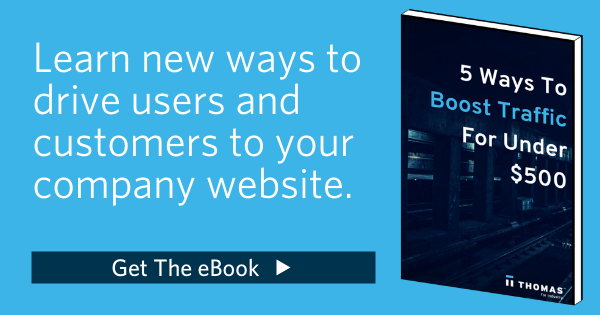Inbound marketing drives customers to your business’ products and services through a coordinated strategy of design, content, social media, and SEO tactics. Most manufacturing and industrial companies may think that inbound marketing is something that would be more suited toward consumer goods and B2C rather than the industry space. But with the digital transformation of sales and marketing, successful B2B companies are now seeing marketing as a direct influence on revenue generation and more manufacturers are aligning their efforts with today’s digital world.
In fact, most industrial manufacturers are practically already set up for an inbound marketing program — they just don’t know it yet.

Think about all the spec sheets, research, data, and product catalogs you have just lying around on a desk or in a drawer somewhere. These materials can be converted into valuable marketing tools to help drive your business forward — these materials just need to be set up the right way.
We’re here to lay out some steps to turn the resources you already have into powerful tools for lead generation.
Step 1: Analyze What You Have
Let’s see what you’ve got.
This means taking a complete audit of all your existing marketing collateral — from old-school paper pamphlets and drawings to the pages of an existing website. You’ve had to answer questions for customers for years, which has manifested in all the material you’ve created — charts, graphs, calculators.
Take a look at what you’ve done, and see what questions it answers. This will help you in the beginning stages of establishing a successful inbound marketing campaign.
Step 2: Decide Who It Is For
It’s critical that your content is targeted toward specific audiences, as different formats can be more appealing to different people.
We call these personas — fictional but well-researched representations of your ideal customer. Personas can vary by industry, job function, and personality. Content that’s planned with specific personas in mind will yield higher conversion rates and more valuable leads. If you’re an OEM, you’re definitely looking to get in front of a design engineer or a procurement manager to get on the approved vendor list, but each company/sector can have different targets.
We have more information on creating and targeting personas in a free eBook, which you can download here.
Step 3: Set Up For Success
Ideally, you already have a website that’s ready to house all of your content, but you may need some updating:
- If you have an existing website, you can create new landing pages with forms (to gather all of your prospects’ information before you give them your content) through Unbounce, HubSpot, or even WordPress.
- If you’re starting from scratch, we recommend you look at using Growth-Driven Design. GDD is an adaptive approach to getting your website up quickly then begin optimizing through A/B testing.
- For OEMs and distributors, you should consider building a robust e-commerce presence that delivers an optimal product experience. Chances are, you already have a process in place — but how up to date is your data? Thomas Connect helps OEMs and distributors solve product data challenges and sell millions of products and components online with consistent, up-to-date data. Learn how Colonial TelTek optimized their e-commerce platform.
Your pages should be presented simply and cleanly, have CTAs that drive to your offers (eBooks, charts, white papers, etc.), and lead your prospects to fill out forms.
But what if you need to create more content? Here are 8 Content Marketing Examples that can kickstart your inbound marketing strategy.

Step 4: Get More Traffic
Now that you’ve got everything set, let’s get more eyeballs on your content — and get more prospects for your sales team to call. Inbound marketing is a web of tactics that includes PPC, SEO, content, blogging, social media, and email — each strategy supporting the others and working together to gather valuable leads.
While each of these channels requires careful individual consideration and content development, there are a few best practices you can leverage to get your campaign off the ground and start capturing visitor info.
Utilize Paid Advertising Like PPC
Do you have the budget to put some paid behind your marketing efforts? Pay-Per-Click may be a great option for you. Paid advertising allows you to target specific audiences based on interests and intent. Paid advertising can potentially give you the most qualified traffic and leads to your site if implemented correctly.
Search Engine Optimization (SEO)
Search Engine Optimization or SEO isn’t about quick fixes, to rank on Google. A good SEO strategy takes time and requires refinement over weeks, months and even years. Pick a primary keyword to focus on for each landing page. Place that keyword in your header and subheader as well as within the body content, page URL, and image alt text.
Tools such as ahrefs or moz are great for doing this keyword research, but if you’re new to the game, here are the SEO basics for manufacturers.
Blogging
Companies that blog multiple times per month with prominent CTAs and hyperlinks to landing pages can see a significant increase in lead volume. Plus, the content is already right at your fingertips — your existing brochures, portfolios, and other materials are great sources for new blog topics.
Social Media Marketing
Believe it or not, many of your potential customers are already on Twitter and LinkedIn, ready to engage with you. Use tweets, hashtags, and discussion forums to create human connections with your prospects and familiarize yourself with the dialogue around your industry. Social media is a great tool for community building, here are 4 steps to grow your social media audience.
Email Marketing
Sending prospects valuable offers such as discounts and educational content, as well as giving them the option to share them with a colleague, is a great way to reach new leads.
All of these tactics can be supercharged by coupling them with industry trends and knowledge. And Thomasnet has the industry insight and data to power the results. With more than 800,000 buyers on the platform, it’s not wonder why so many B2B manufacturing and industrial companies list their business for free to get seen by the right audience.
Need some tips, tricks and ideas on generating industrial leads? Here are 30 Ways To Generate Leads.
Step 5: Collaborate With Sales
As much work as you’ve put in to get there, your job isn’t done once you’ve gotten leads; your sales team still needs to close them. You need feedback on the leads, and you’d probably like to quell your curiosity on how they’re moving through the sales funnel.
This becomes infinitely easier when using a Customer Relationship Management (CRM) tool to keep your growing list of contacts organized. With a CRM, your team can evaluate new prospects through a scoring system, send tracked emails, and make calls to the most qualified leads.
It’s crucial to close the loop for effective marketing, so you have an understanding of what initiatives and tactics are most successful in bringing in new customers.
Final Thoughts
Don’t get stuck with your old process. Staying ahead of your competition doesn’t mean just optimizing efficiencies on the plant floor. There are opportunities for growth within your marketing and sales departments too. Need more insight how you can supplement your traditional sales tactics with the above steps? Download How Inbound Marketing Drives Growth For Manufacturers. And if you’re struggling to tap into the digital space, contact our team of manufacturing marketing experts.


